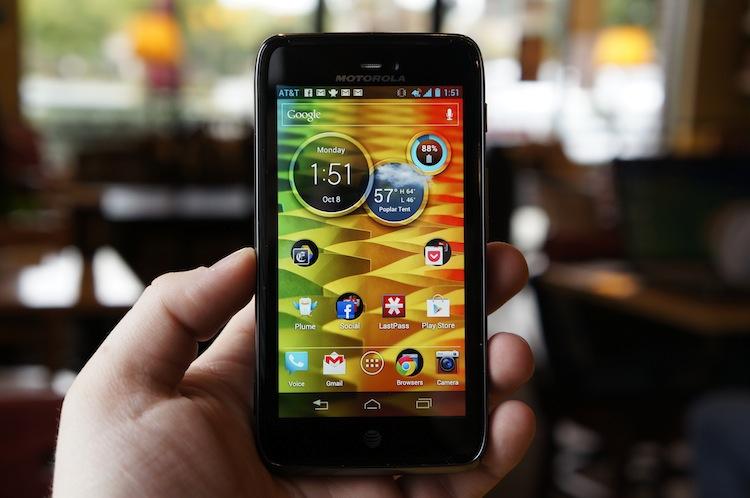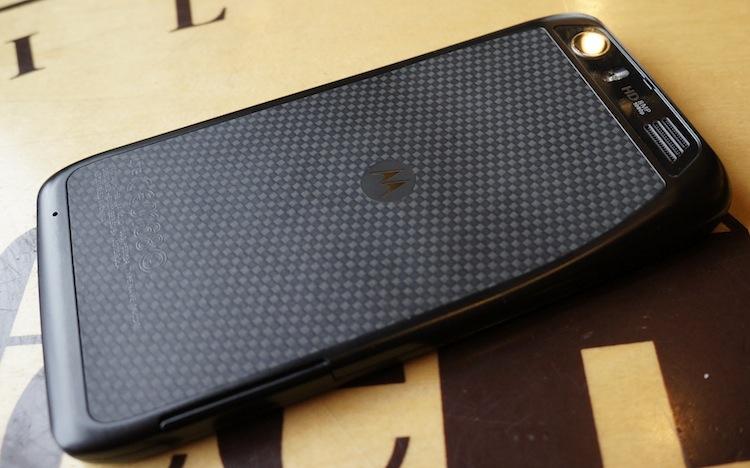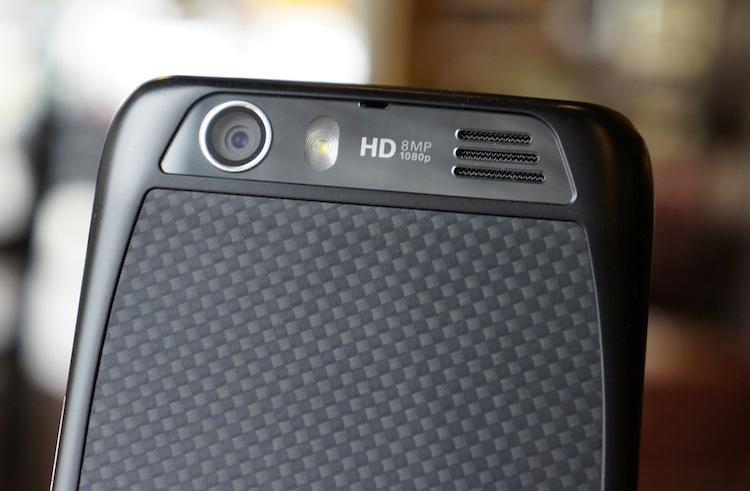
We go through a lot of phones here at PhoneDog, and the Motorola Atrix HD for AT&T is definitely one the more interesting handsets. On the inside, it hosts some of the more common high-end specifications, yet it doesn't bear a huge price tag. For $99.99 with a two-year agreement, the Motorola Atrix HD is a great deal.
That said, it's up against some stiff competition, and the holiday season will surely bring some serious competitors. Should the Atrix HD be your next smartphone? Or should you spring for the slightly older HTC One X, the newer Apple iPhone 5 or the more expensive Samsung Galaxy S III?
I have spent several days using the Motorola Atrix HD as my personal device, and here's my take:
From a distance, the Motorola Atrix HD resembles a mix between its predecessor, the Atrix 2, and DROID RAZR HD with softer, more rounded corners. On the back is features the same kevlar backing we've come to expect on Motorola devices, and the face is the same buttonless, bezel-heavy face the upcoming DROID RAZR HD and DROID RAZR MAXX HD bear.

On the front of the device is a 4.5-inch TFT 720p display, a tiny speaker grill, a 1.3-megapixel front-facing camera and AT&T branding. On the upper right edge you will find a textured power button and a smooth volume rocker. The top edge hosts the 3.5mm headphone jack, micro USB port and micro HDMI out port. And on the lower half of the left edge is a pivoting cover that hides the micro SIM and micro SD card slots. Lastly, on the top of the back panel is an 8-megapixel camera, LED flash and a loud speaker, along with some Motorola branding.
Looks, however, are only half the story. Motorola has set the bar pretty high in build quality, and it's not that the Atrix HD is lacking in the quality of its build. But the design is definitely lackluster, as are the materials used in its chassis. It's lightweight, which can be a good thing. But the Atrix HD feels cheap. Despite what the device is packing under its hood, the soft, rounded edges and hard, hollow plastic that make up the back half of the device give it the feel of a feature phone or low-end smartphone in the hand, not that of a high-end device.
Other than that, my only complaint with the hardware is the micro USB and micro HDMI ports are on the top of the device. This is, of course, to make it compatible with Motorola's Lapdock (but those have already been nixed). Although it's not the first smartphone to charge from the top, it's definitely odd placement and the power cord seems to get in the way while using the handset. Overall, the Atrix HD is built very well, but design and materials used are lacking serious finesse.

The Motorola Atrix HD ships with Motorola Applications Platform (MAP) running atop Android 4.0.4, Ice Cream Sandwich. Side by side with TouchWiz and Sense 4, MAP is definitely the closest to stock of any of the major custom interfaces. In fact, most of the stock elements are still intact. MAP only introduces a handful of widgets, new icons, a different lock screen, home screen customizations beyond those of stock Android and the SmartActions application. I was surprised to find I actually like the software – it's a far cry and a dramatic improvement over Motorola's previous Android interface, MOTOBLUR.
The meat of the changes is SmartActions, which allows the user to automate various actions based on an array of 12 triggers, such as location, motion detector, battery level, calendar events and more. Using those triggers, the user can then tell the phone what to do, choosing from: changing display brightness, toggling Wi-Fi or Bluetooth off, sending a text message, changing the wallpaper an much more. The user can also choose from nine preset rules. SmartActions is very neat and adds tons of value to MAP, though it's not the only automating software. Tasker, a strikingly similar application, can be purchased from the Play Store.
On the face of the Atrix HD is a 4.5-inch TFT 720p display. Surprisingly, the TFT panel Motorola used is quite clear. Color reproduction seems fairly accurate, though it errs on the side of over-saturation similar to Samsung's famed Super AMOLED panels. Where the TFT panel comes up short, though is in its blacks. Side by side with the iPhone 5 and HTC One X, the blacks aren't nearly as inky on the Atrix HD's display. At 326ppi, however, it shares the same density as the iPhone 5's 4-inch panel, meaning it is extremely clear with no noticeable grain or pixelation.
Overall, the display is gorgeous, but not the best on the market.

The worst part about the display, though, is how much battery it consumes. It's a very bright panel, and even on very low brightness, the display manage to use a staggering 79 percent of the battery, which fell from 100 to 79 percent in just 40 minutes of very heavy usage. I can't ever recall seeing a display consume more battery than the Atrix HD's panel at 79 percent, but the average battery consumption hovered between 59 and 65 percent.
While I'm on the topic of battery life, the Atrix HD stumbles quite a bit in terms of stamina. It features a 1,780mAh battery, yet I struggled time and time again to make it through an entire day, even with light to moderate usage. Yesterday, I made it just 8 hours and 40 minutes of mostly just standby before having to plug the device in. Given that Motorola is giving priority to battery life in some of its higher profile devices, the Atrix HD's poor stamina is disappointing.

Under the hood, the Atrix HD features a processor we're all quite accustomed to by now, the 1.5GHz dual-core Krait processor, and it features the Adreno 225 GPU, collectively making the Snapdragon S4 chipset. Unfortunately (and unexpectedly), I noticed quite a bit of stuttering from the Atrix HD during heavy usage. That said, the brunt of the lag was during the initial boot and setup process. I had 49 applications in the queue to be installed or updated, which was quite taxing on the processor. However, I have put the S4-bearing One X and Galaxy S III through similar stress tests and fared notably better in performance. Through normal, light usage, hiccups were few and far between, but through extensive multitasking, the phone will begin to slow down and take more time to switch between apps.
On AT&T's LTE network, the Atrix HD brought in decent speeds. In the Charlotte metro area, I managed to average about 31.43Mbps down and 16.74Mbps up. The fastest download speeds reached were 44.63Mbps while the upload speeds topped out at 22.64Mbps. This doesn't quite match the Pantech Flex speeds, which maxed out at 60Mbps, but it's nothing to scoff at either.
I didn't have a chance to place too many calls over the weekend, but the few calls I did make were great. The earpiece speaker is very loud and crisp, as is the loudspeaker around back for speakerphone. Unlike the Pantech Flex, there were no tinny sounds and the microphone seemed crisp as well. I received no complaints from people on the other end about microphone clarity or background noise. All good things to report on this front.

The camera is the undisputed low point of the Atrix HD. Motorola phones aren't normally commended for their image sensors, but the Atrix HD is unusually poor, even for Motorola. The camera software is lacking fine details. The user can manipulate exposure, toggle flash and switch between various modes, such as Panorama, Single shot, Multi-shot, Timer or HDR. But beyond that, there are only a few scenes to activate and nine filters to use.
Looking past the lack of camera features, the performance isn't great either. In both low-light and well-lit conditions, the camera had trouble focusing properly. Even in the one of 10 that was properly focused, pictures were riddled with noise and a lack of detail. The more prominent error was in exposure – it wanted to either under- or over-expose. Given perfect lighting, you may manage to snap a decent photo, but the shutter speed is nothing to write home about either. After tapping the on-screen shutter button, the phone will pause for a split second before taking the picture. Even when switching to Multi-shot (or burst mode), there is still a noticeable lag.

On paper, the Motorola Atrix HD has everything necessary to land it in the highest tier in the smartphone market. But the overall package falls short in contrast with the competition. The display is gorgeous and as crisp as you can ask for, the processor is the same one found in the Samsung Galaxy S III and HTC One X on AT&T and the software is as close to stock Android as you can get without buying a Nexus.
However, the camera isn't nearly in the same class as ImageSense on the One X, the fine shooter on the S III or the iPhone 5. Battery life is a sore point, too, as is the design and finish of the phone.
The Atrix HD is a decent phone, but just a few months old, it's already starting to show its age amongst its Motorola-made brethren, such as the DROID RAZR M, DROID RAZR HD and DROID RAZR MAXX HD. Unfortunately, for $99.99 and a two-year agreement with AT&T, you can certainly find a better phone
What's Good: Affordable at $99.99 with an agreement; crystal clear and vibrant display; built well; snappy S4 chipset; near stock Android interface; great LTE speeds.
What's Bad: Poor camera; mediocre design and materials; poor battery life; laggy under extensive use.
The Verdict: The Motorola Atrix HD is a modest entry from Motorola and AT&T, at best. It is neither the best or worst phone on the market, and it's priced appropriately. However, I feel there are better devices with more value in all the surrounding price ranges – at $50, $100 and $200.